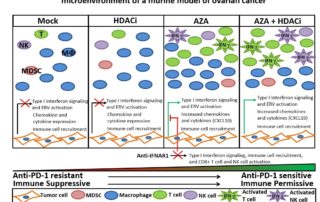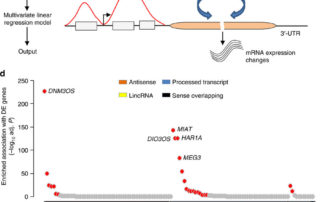Combination Strategy Could Hold Promise for Ovarian Cancer
Combination Strategy Could Hold Promise for Ovarian Cancer December 5, 2017 Johns Hopkins Kimmel Cancer Center researchers demonstrated that mice with ovarian cancer that received drugs to reactivate dormant genes along with other drugs that activate the immune system had a greater reduction of tumor burden and significantly longer survival than those that received any of the drugs alone. The study already spurred a clinical trial in ovarian cancer patients. The investigators, led by graduate student Meredith Stone, Ph.D.; postdoctoral fellow Kate Chiappinelli, Ph.D.; and senior author Cynthia Zahnow, Ph.D., believe it could lead to a new way [...]
Researchers advance technique to detect ovarian cancer
Researchers advance technique to detect ovarian cancer November 30, 2017 Researchers at Rice University and the University of Texas MD Anderson Cancer Center have refined and, for the first time, run in vivo tests of a method that may allow The noninvasive technique relies on single-walled carbon nanotubes that can be optically triggered to emit shortwave infrared light. The Rice lab of chemist Bruce Weisman, a pioneer in the discovery and interpretation of the phenomenon, reported the new results in the American Chemical Society journal ACS Applied Materials and Interfaces. Rice University and MD Anderson researchers have [...]
Decoding the molecular mechanisms of ovarian cancer progression
Decoding the molecular mechanisms of ovarian cancer progression November 28, 2017 Identifying critical lncRNA in ovarian cancer EMT. a Ovarian cancer patients (n = 320) with genomic and molecular profiling data that classified into epithelial (Epi; n = 231) or mesenchymal (Mes; n = 89) subtypes were selected for analysis. b Heatmap of 386 genes that were differentially expressed in the mesenchymal subtype compared with the epithelial subtype. cInferring deregulatory programs from ovarian cancer profiling data. Change in mRNA expression is modeled as linear function of the gene’s DNA methylation, copy number, and lncRNA expression. d, e Systematic prediction of EMT-linked lncRNA from the lncRNA-gene association information obtained from the linear model. d The [...]
New Blood Test Developed to Diagnose Ovarian Cancer
New Blood Test Developed to Diagnose Ovarian Cancer October 31, 2017 Investigators from Brigham and Women’s Hospital and Dana-Farber Cancer Institute are leveraging the power of artificial intelligence to develop a new technique to detect ovarian cancer early and accurately. The team has identified a network of circulating microRNAs – small, non-coding pieces of genetic material – that are associated with risk of ovarian cancer and can be detected from a blood sample. Their findings are published online in eLife. Most women are diagnosed with ovarian cancer when the disease is at an advanced stage, at [...]
Scientists track ovarian cancers to site of origin: Fallopian tubes
Scientists track ovarian cancers to site of origin: Fallopian tubes October 23, 2017 A genomic study suggests that most ovarian cancers originate in the fallopian tube. Credit: Carolyn Hruban Some scientists have suspected that the most common form of ovarian cancer may originate in the fallopian tubes, the thin fibrous tunnels that connect the ovaries to the uterus. Now, results of a study of nine women suggest that the genomic roots of many ovarian tumors may indeed arise in the fallopian tubes, potentially providing insights into the origin of ovarian cancer and suggesting new ways [...]






